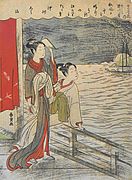Shiba Kōkan
Shiba Kōkan ( Japanese 司馬 江漢 ; born 1747 in Edo ; died 1818 ibid) was a Japanese painter of the Ranga or Yōfuga school. He was interested in science and also worked as an essayist . His real name was Andō Shun ( 安藤 峻 ), as a writer he used u. a. the name Shumparō ( 春波 楼 ).
Life
Shiba Kōkan was born in Edo. He first studied painting in the Kanō School , then was influenced by Suzuki Harunobu . In his early creative period he called himself Harushige and created ukiyo-e in the style of Suzuki Harunobu, with whose signature he also provided some of his colored woodcuts after his death in 1770 . Under Sō Shiseki he learned the realistic representation of flowers and birds, as taught by the Chinese artist in Nagasaki , Shen Quan . He also studied painting in the Nanga style.
The interest in Western painting by Hiraga Gennai and Odano Naotake spurred on. Kōkan acquired the technique and theory of Western painting as conveyed by books that came from Europe to Dejima in Nagasaki. In 1783 he succeeded in producing etchings such as a series on Edo, a. a. the landscape at Mimeguri (三 目 黒 景 図) and The Shinobazu Pond (不忍 池, Shinobazu-no-ike), occupied. In 1788 he visited Nagasaki and interviewed the official interpreters about western painting and culture.
In the years of the Kansei period (1789-1801) Kōkan produced a large number of works, including oil paintings, so that he became the undisputed leader in Western art. He also wrote books on astronomy and geography, helping to introduce western science to Japan. Of particular importance, however, is his “Conversation on Western Painting”, which is one of the few books on this subject from the Edo period.
Kōkan was the first to place Western painting above Chinese and Japanese, as it took light and shadow into account and was more suitable for book illustrations. His work contains pictures based on European models, but also many landscapes from the area around Edo.
Kōkan's best-known works include the two oil paintings that belong together in the Kōbe City Museum with the title "Europeans, Man and Woman" (紅毛 男女 図, Kōmō danjo).
Fonts (selection)
- Seiyū hikki (diary of a study trip to the west)
- Shumparō hitsuki (Shumparō's writings)
- Tenchi ritan (theory of heaven and earth)
- Seiyō gaden (西洋 画 伝)
plant
Seven-mile beach with Enoshima
Remarks
- ↑ Kōmō 紅毛 literally means "the redheads". It is not meant to be derogatory. - According to Naruse, copperplate engravings from the book Het menselyk bedryf by Jan and Caspar Luyken, Amsterdam 1694, were used as models .
- ↑ from a series of the type Snow, Moon and Flowers
literature
- Tazawa, Yutaka: Shiba Kōkan . In: Biographical Dictionary of Japanese Art. Kodansha International, 1981. ISBN 0-87011-488-3 .
- Naruse, F .: Shiba Kōkan. Publishing house Shueisha 1977.
- Laurence P. Roberts: Kōkan . In: A Dictionary of Japanese Artists. Weatherhill, 1976. ISBN 0-8348-0113-2 .
Web links
| personal data | |
|---|---|
| SURNAME | Shiba, Kōkan |
| ALTERNATIVE NAMES | 司馬 江漢 (Japanese); Andō Shun (real name); 安藤 峻 (real name, Japanese); Shumparō (writer's name); 春波 楼 (writer's name, Japanese) |
| BRIEF DESCRIPTION | Japanese painter and writer |
| DATE OF BIRTH | 1747 |
| PLACE OF BIRTH | Edo |
| DATE OF DEATH | 1818 |
| Place of death | Edo |





